 Needs Pictures: 0
Needs Pictures: 0
Results 1 to 15 of 18
Thread: The Last Moxon Dovetail Vise
-
22nd September 2019, 05:12 AM #1
 The Last Moxon Dovetail Vise
The Last Moxon Dovetail Vise
Many of my projects involve bow fronts, which result in compound angle dovetails ...

I do enjoy building furniture with dovetailing challenges.
Between furniture pieces, I find time to build a new tool. This time it is the Moxon dovetail vise I have been promising myself for a while. My first and only one was built in early 2011, after Chris Schwarz helped put it on the map. I immediately modified this design, and have been making modifications since. (Link: http://www.inthewoodshop.com/ShopMad...etailVise.html). This new Moxon incorporates the best ideas.
Ironically, this design is not geared for compound angles. I decided to heed my own advice and keep it as simple as possible, and cater for the 90% of the dovetailing that is likely to be done.
The width of the vise is narrower than my previous one, but capable of 450mm (17 3/4")between the screws. Most cases I built are between 350 - 450mm deep. My previous Moxon could do 560mm (22") between the screws. This is unnecessary, and just makes for a very large fixture.
Where the old Moxon used wooden screws, which I turned, this uses steel Acme screws and iron wheels ala BenchCrafted ... except that these came via Tom Bussey (thanks Tom), which amounted to a large savings. The wheels are 5" in diameter on a 3/4" screw.
The front chop is 5 1/2" high, and the Moxon is built in Jarrah ... what else do you expect! I went a little OTT in this build, but it was fun, and I admit I did become a little carried away
I went a little OTT in this build, but it was fun, and I admit I did become a little carried away 

Brass inlay ...

The chop runs on bronze bushings ...
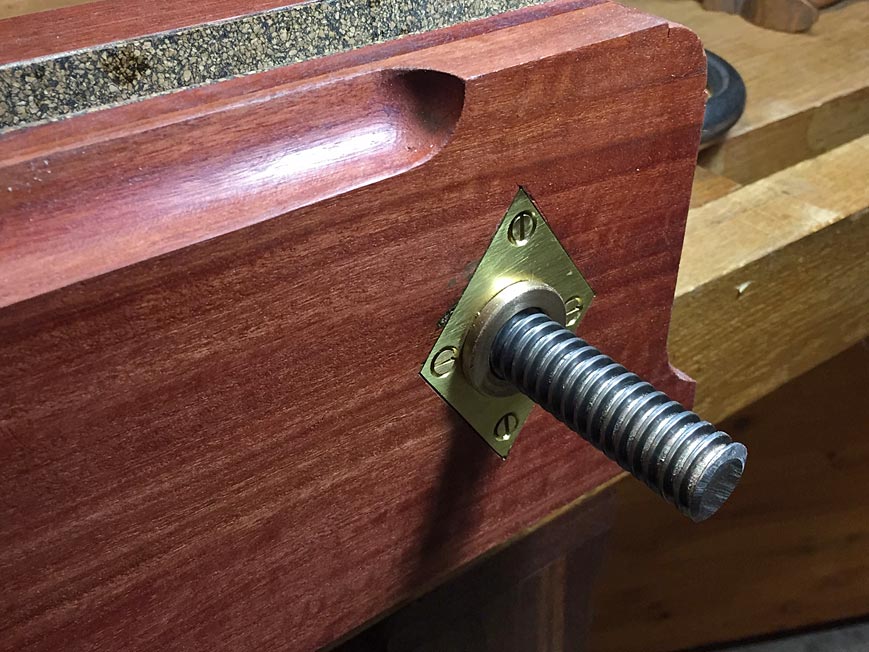
Lining the inside of the vise is rubberised cork. This makes a great non-slip (not my idea - this comes from BenchCrafted, who call it "crubber". Simply search eBay for "cork rubber").

This vise is a good height for sawing ...
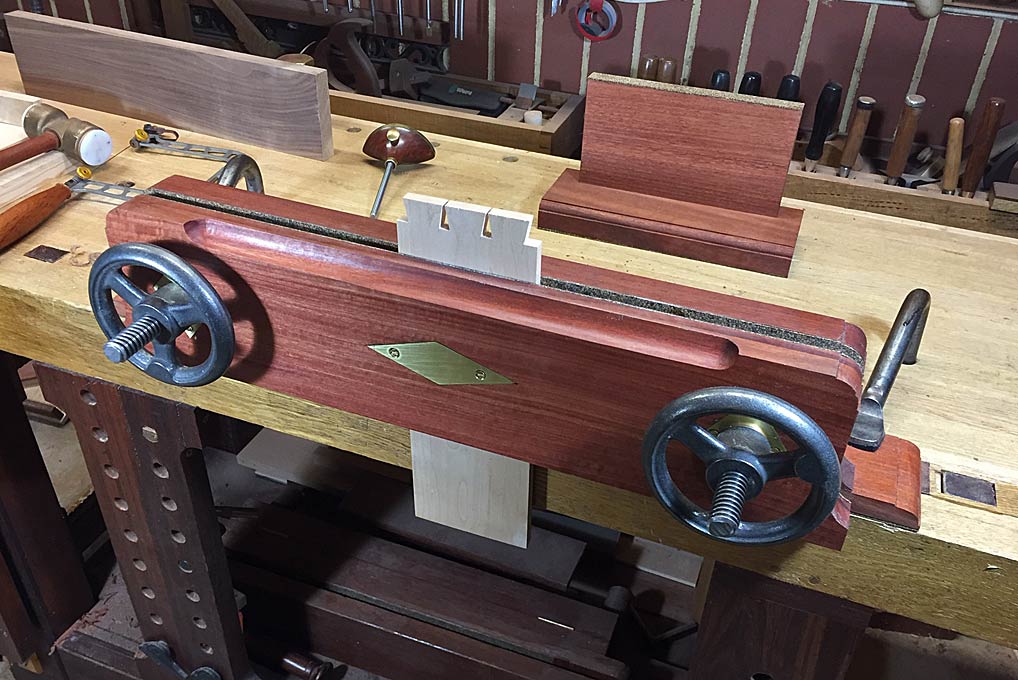
There are a few innovations. The rear of the vise ...
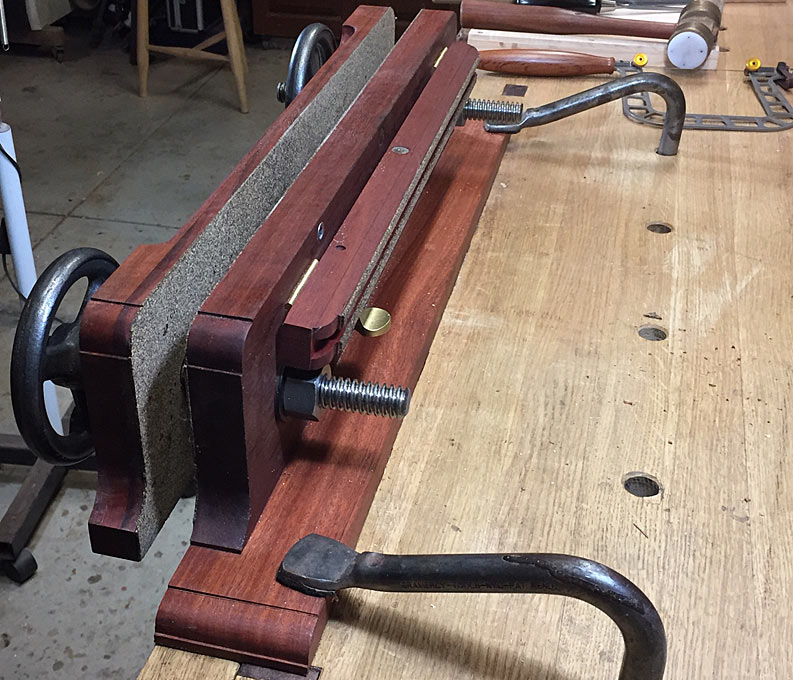
This is a spacer, and it can be locked into the up position ...
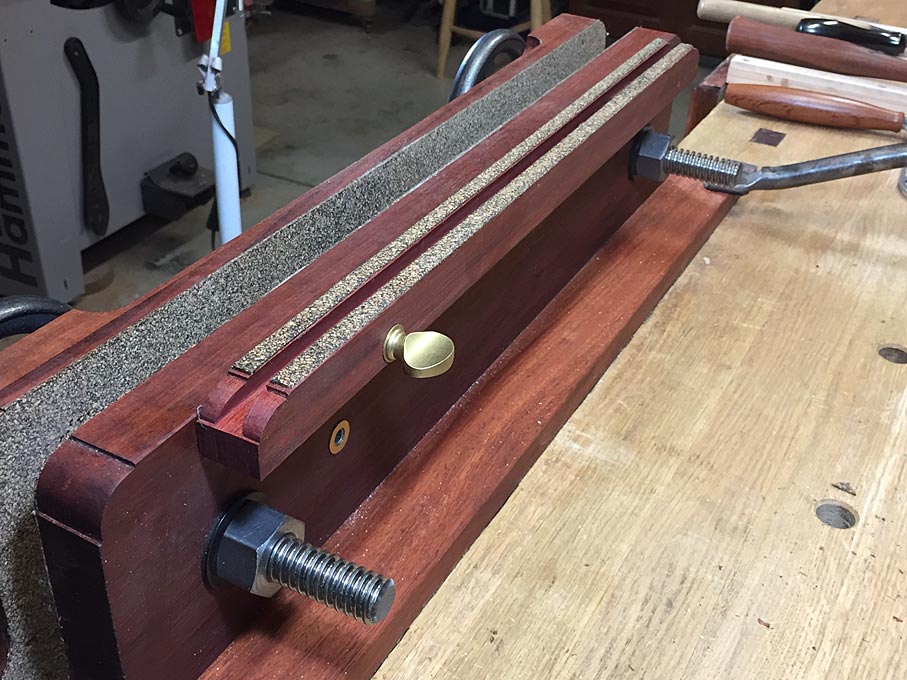
The spacer has two functions. The first is setting the pin board (10mm) above the chop to prevent scoring the chop when transferring tails to pins with a knife (this is more of a danger with through dovetails). Also, by lifting the work, there will be light behind the pin board, and this makes it easier to align the edges.

The crubber makes a great non-slip.
The spacer may be dropped out of the way, once the height is set ...
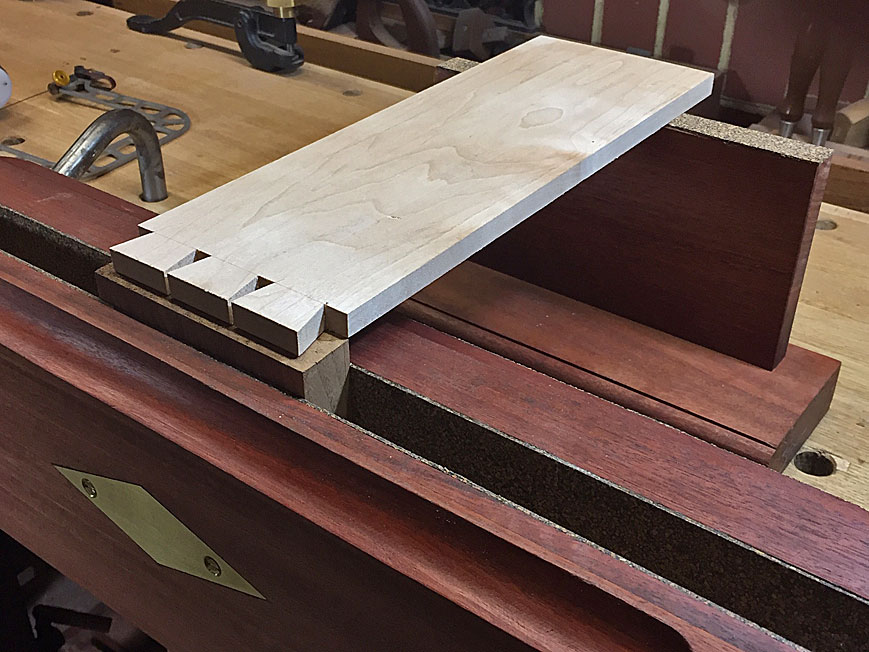
The second use of the spacer is that it has a sliding dovetail at the top, and this allows for the use of MicroJig clamps. This would be especially useful for holding wide boards, or tail board which have developed a slight bow ...
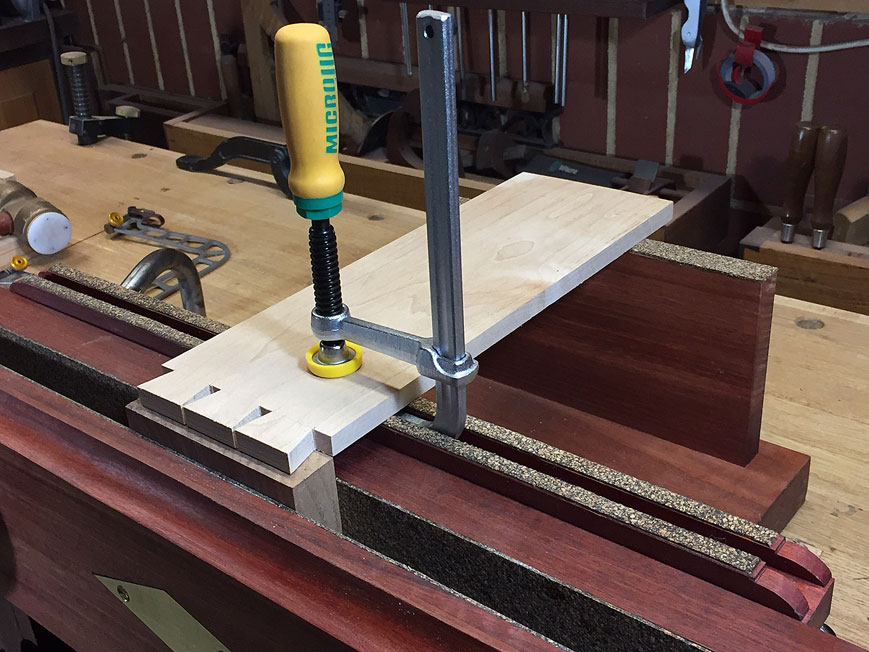

I have used this on other fixtures, such as a morticing jig.
For aligning the tail- and pin boards, I prefer a simple wide square I made from wood ...
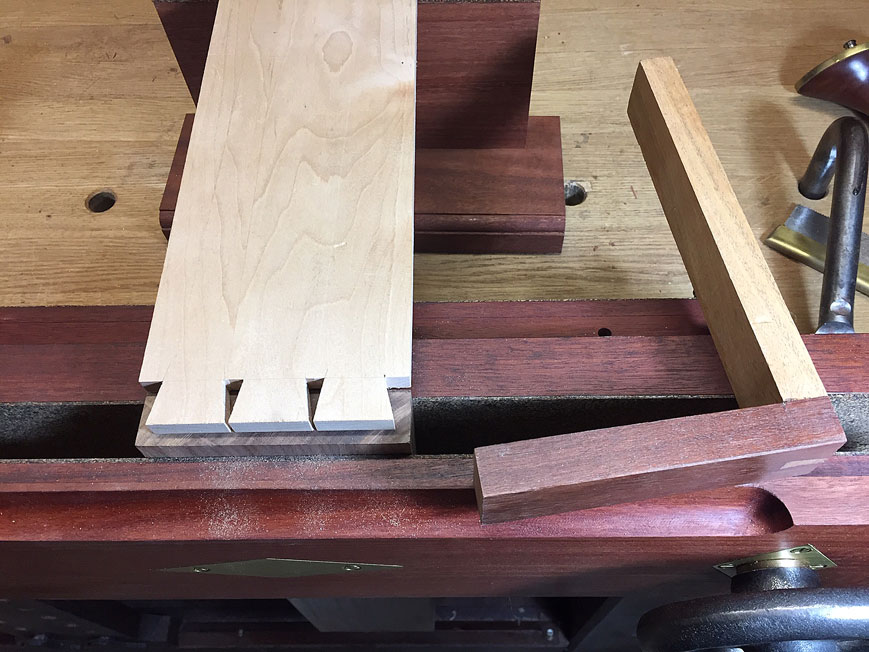
The spacer needs to be dropped out of the way for this ...

Once transfer is made, reverse the board and saw the pins. This is where you will recognise that the cove is not simply decoration, but allows the saw to angle and get closer to the work piece. The lower the work piece in the vise, the less vibration when sawing ...

And thats it ... the last moxon dovetail vise ...
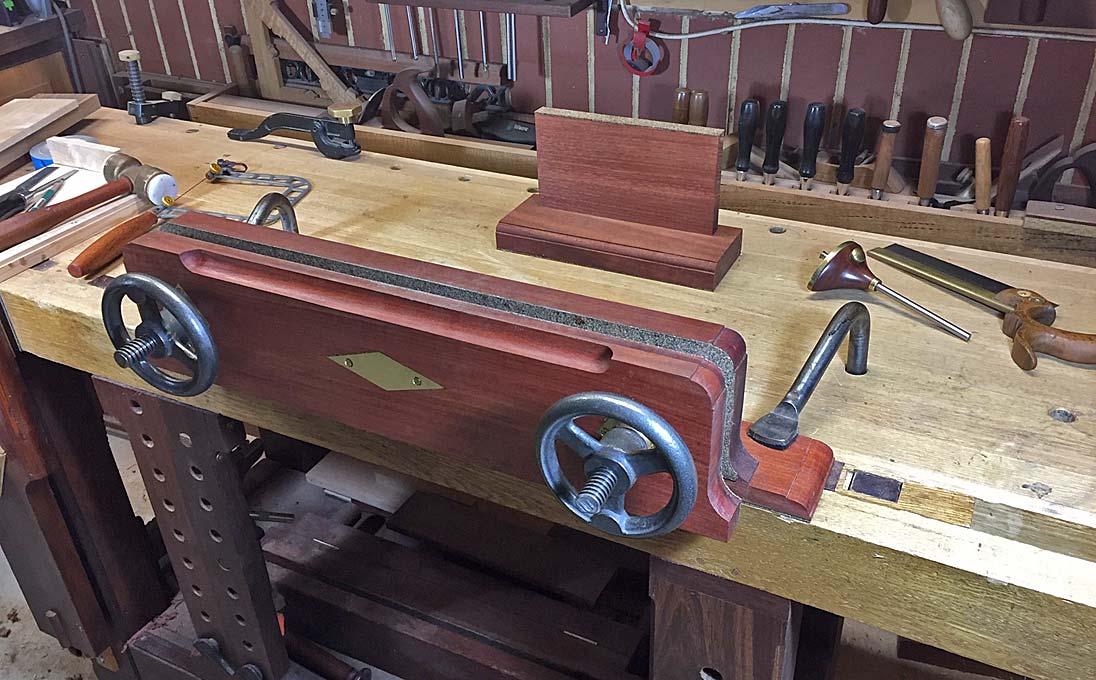
Regards from Perth
DerekVisit www.inthewoodshop.com for tutorials on constructing handtools, handtool reviews, and my trials and tribulations with furniture builds.
-
22nd September 2019 05:12 AM # ADSGoogle Adsense Advertisement
- Join Date
- Always
- Location
- Advertising world
- Posts
- Many
-
22nd September 2019, 05:50 AM #2
 SENIOR MEMBER
SENIOR MEMBER











- Join Date
- Jan 2010
- Location
- Auckland New Zealand
- Posts
- 312

I like it. Very nice work Derek. Now all that you need to do is start selling kits for the hardware so that I can make one as well [emoji16]
-
22nd September 2019, 10:13 AM #3

As we have come to expect from you, Derek, very nicely put together and exceedingly cunning

-
22nd September 2019, 09:54 PM #4
 GOLD MEMBER
GOLD MEMBER











- Join Date
- May 2009
- Location
- melb
- Posts
- 1,125

Looks like a great set up. Who is Tom Bussey and if one wishes to purchase the screws how would we get in contact with him?
-
22nd September 2019, 11:50 PM #5

Tom is in the USA. Acme threads and cast iron wheels are common place there. I could not find a seller in Oz. Tom accessed and shipped a set to me. Possibly not quite in BenchCrafted territory (but are very close - I have a BC tail vise), however they were half the price.
Regards from Perth
DerekVisit www.inthewoodshop.com for tutorials on constructing handtools, handtool reviews, and my trials and tribulations with furniture builds.
-
23rd September 2019, 12:34 AM #6
 GOLD MEMBER
GOLD MEMBER











- Join Date
- Jun 2005
- Location
- Helensburgh
- Posts
- 7,696

ACME threaded rod Mild Steel Rod, ACME Plain, Threaded Rod, Fasteners | Bolts & Industrial Supplies
Wheels here Handwheels & Handles – Machine | Power Transmission | Blackwoods
These are the first two links I found and there are more. Great job Derek, it is good to see stuff like this done well.CHRIS
-
23rd September 2019, 12:50 AM #7

Chris, thanks for the links. I did many searches without coming up with a lead.
The ACME link appears to sell only in 12 foot lengths: $645 (I have 2 x 12" lengths, which would cost $108 equivalent).
The cheapest 5" hand wheel on the other link is $102 each ($204 for 2).
Then there are ACME nuts and washers, plus brass bushings. And postage for each item from different sellers.
I paid $160 USD including shipping from the USA ($230 AUD).
Timbecon were asking $355 for the BenchCrafted set, but it has been out of stock for at least a year.
Regards from Perth
DerekVisit www.inthewoodshop.com for tutorials on constructing handtools, handtool reviews, and my trials and tribulations with furniture builds.
-
23rd September 2019, 11:33 AM #8
 GOLD MEMBER
GOLD MEMBER











- Join Date
- Jun 2005
- Location
- Helensburgh
- Posts
- 7,696

I guess the ACME rod would be a similar price in the US but it has been cut down for each user. The wheels are available from several sources including RS components but I would ring Terry Gordon and see what he could do as he sources them for his vice builds. I bet he uses ACME rod also and might be able to supply shorter lengths.
CHRIS
-
23rd September 2019, 01:19 PM #9
 SENIOR MEMBER
SENIOR MEMBER











- Join Date
- Mar 2018
- Location
- Sydney
- Posts
- 469

Hi Derek,
That's a really nice design.
Could you explain why you dropped the David Barron style integrated alignment jig you had in the prior version?
Regards,
Adam
Sent from my SM-G950F using Tapatalk
-
23rd September 2019, 05:55 PM #10

Hi Adam
The reason I dropped the side alignment square (ala David Barron) is that I found it limiting. The Barron board (which, incidentally, is not his design) only works for boards that are aligned with squared ends. Over the past few years, many of the boards I have dovetailed are to fit drawers with bow fronts. The sides do not begin in the usual way, but like this ...
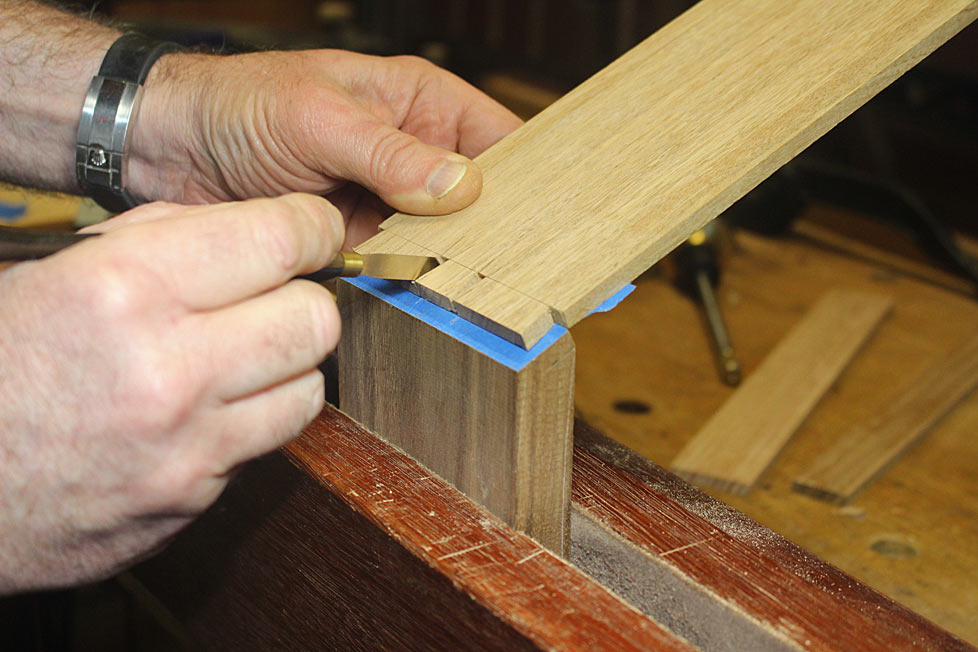
The side fence simply does not offer anything for me. In the end, I removed it from the previous Moxon modification (and carefully filled in the mortices).
The loose wooden square I show in the article above has far greater flexibility. It is very accurate (the drawers do not rock when placed flat downward).
I was tempted to build a variable angle Moxon, but this was getting to be bigger than Ben Hur, and left well alone.
Regards from Perth
DerekVisit www.inthewoodshop.com for tutorials on constructing handtools, handtool reviews, and my trials and tribulations with furniture builds.
-
23rd September 2019, 06:02 PM #11
 SENIOR MEMBER
SENIOR MEMBER











- Join Date
- Mar 2018
- Location
- Sydney
- Posts
- 469

Hi Derek,
Thanks for the great explanation.
Maybe the variable angle will be on your next "last moxon vice" [emoji4]
Sent from my SM-G950F using Tapatalk
-
28th September 2019, 06:40 AM #12
 SENIOR MEMBER
SENIOR MEMBER











- Join Date
- Oct 2012
- Location
- brisbane
- Posts
- 848

Helpful thread thanks Derek. Could you tell me what thickness the chops are by chance. I’ve seen some popular commercial units at greater than 40mm thick which seems unnecessary to me. Yours appear thinner which appeals to me in reducing weight. Thanks in advance.
-
28th September 2019, 07:51 AM #13
 SENIOR MEMBER
SENIOR MEMBER











- Join Date
- Feb 2015
- Location
- Hobart
- Age
- 77
- Posts
- 648

Hi Derek,
Thanks for showing the detailed anatomy of your last Moxon vise.
Where were you able to source the brass bushings?
Cheers Yvan
-
28th September 2019, 10:14 AM #14

Mine are about 30mm. Where those "commercial units" made in the USA? I've seen some extremely thick examples there. What will determine the thickness of the timber is its flex. Jarrah is hard and does not flex like a softer wood can. The chop of my leg vise is probably the same thickness, and this has been fine. I've seen some in the USA that were over 50mm thick. It seems overkill to me.
Regards from Perth
DerekVisit www.inthewoodshop.com for tutorials on constructing handtools, handtool reviews, and my trials and tribulations with furniture builds.
-
28th September 2019, 10:20 AM #15

Yvan, I searched via the Internet and could not find a local source who sold Imperial sizes (the thread is 3/4"), so purchased from a USA-based seller (I cannot recall whom). Ironically, I wound up widening the internal size as it performs better when loose (so there is nothing to prevent you getting a Metric size that is close). The bushing is really to reduce wear (of wood on steel) than improve movement.
Regards from Perth
DerekVisit www.inthewoodshop.com for tutorials on constructing handtools, handtool reviews, and my trials and tribulations with furniture builds.
Similar Threads
-
An improved Moxon vise
By derekcohen in forum HAND TOOLS - UNPOWEREDReplies: 3Last Post: 24th June 2019, 10:16 PM -
VICTORIA Benchcrafted Moxon Vise
By Cin in forum WOODWORK - Tools & MachineryReplies: 2Last Post: 13th March 2018, 03:16 PM -
Moxon Vise
By VikingCode in forum WOODWORK - GENERALReplies: 3Last Post: 23rd August 2016, 10:43 AM -
Original Moxon Vise.
By DSEL74 in forum WOODWORK - GENERALReplies: 0Last Post: 2nd June 2013, 12:00 PM -
My Moxon dovetail vise
By derekcohen in forum HAND TOOLS - UNPOWEREDReplies: 22Last Post: 2nd April 2011, 03:44 PM



 Thanks:
Thanks:  Likes:
Likes:  Picture(s) thanks:
Picture(s) thanks: 
 Reply With Quote
Reply With Quote
